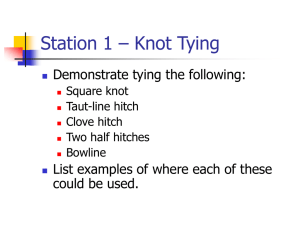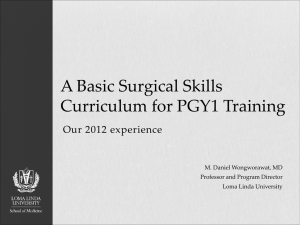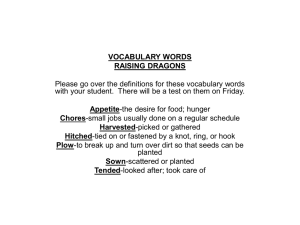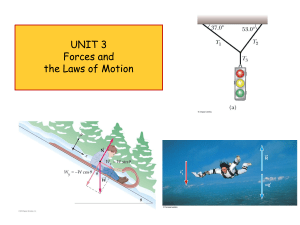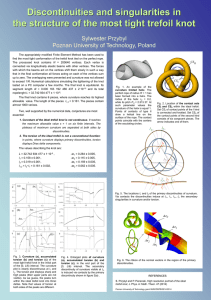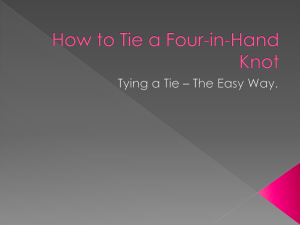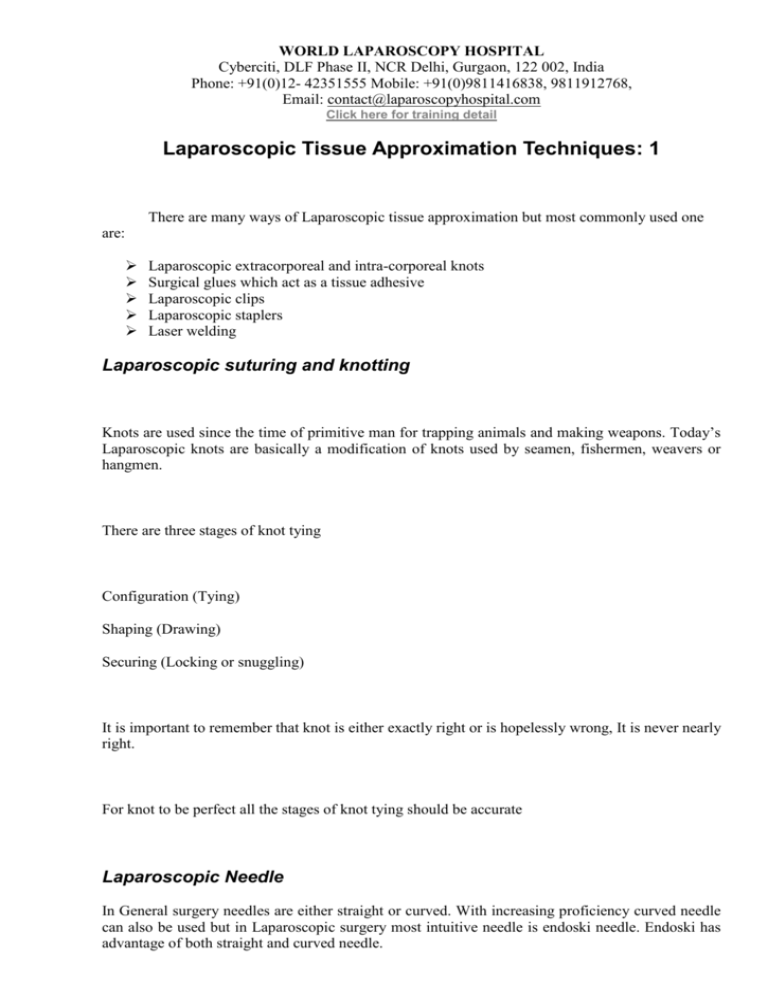
WORLD LAPAROSCOPY HOSPITAL
Cyberciti, DLF Phase II, NCR Delhi, Gurgaon, 122 002, India
Phone: +91(0)12- 42351555 Mobile: +91(0)9811416838, 9811912768,
Email: contact@laparoscopyhospital.com
Click here for training detail
Laparoscopic Tissue Approximation Techniques: 1
There are many ways of Laparoscopic tissue approximation but most commonly used one
are:
Laparoscopic extracorporeal and intra-corporeal knots
Surgical glues which act as a tissue adhesive
Laparoscopic clips
Laparoscopic staplers
Laser welding
Laparoscopic suturing and knotting
Knots are used since the time of primitive man for trapping animals and making weapons. Today’s
Laparoscopic knots are basically a modification of knots used by seamen, fishermen, weavers or
hangmen.
There are three stages of knot tying
Configuration (Tying)
Shaping (Drawing)
Securing (Locking or snuggling)
It is important to remember that knot is either exactly right or is hopelessly wrong, It is never nearly
right.
For knot to be perfect all the stages of knot tying should be accurate
Laparoscopic Needle
In General surgery needles are either straight or curved. With increasing proficiency curved needle
can also be used but in Laparoscopic surgery most intuitive needle is endoski needle. Endoski has
advantage of both straight and curved needle.
Figure 1Endoski Needle
The distal end is tapered half circle and proximal shaft of the needle is straight. The shaft of the
needle is 1.5 times the length of curved portion of endoski needle.
In our day to day practice we can convert half circled needle into endoski shaped by making
proximal half of the needle straight.
Laparoscopic Suture Material
Although it is a personal preference varies surgeon to surgeon but considering handicapped of
laparoscopic setting following is recommended.
For extracorporeal suturing of small tubular structure like cystic duct and small blood vessels dry
chromic catgut
For Extracorporeal suturing of thick tubular structure like appendix and large blood vessels PDS
For intracorporeal continuous or interrupted suturing Vicryl
For intracorporeal interrupted suturing in the repair of hernia, Fundoplication and rectopexy Dacron
(polyester) or silk.
Types of Laparoscopic Surgical Knots
Extracorporeal (Tied outside the body and then slipped inside using a push rod)
– Roeder’s knot
– Meltzer’s knot
– Tayside knot
Intracorporeal (Tied with the help of needle holder within the body cavity)
– Square knot
– Surgeons knot
– Tumble square knot
– Dundee jamming knot
– Aberdeen termination
A long length of ligature is required (90cm) for extracorporeal suturing. It must be long
enough to have the knot pusher threaded on to it, to be passed into the abdomen, round the structure
to be ligated and to be brought out again and still have sufficient length for the surgeon to tie his /
her knot effectively.
The type of extracorporeal knot chosen to complete the loop depends on the clinical situation and
the material used.
Roeder’s Knot
Step1. One half knot is taken first
Step2. Three rounds are taken in front of the first half knot over both the limb of loop.
Step3: A second half knot is taken around one side of loop
Step4:
Knot is stacked properly and then slide on the long standing part of the thread
Roeder’s knot is 1:3:1
One hitch three winds and one locking hitch
The Meltzer slip knot
This modification of the Roeder knot was described in 1991 by Meltzer for use with PDS,
and has now superceded the use of Roeder’s knot. It has four components:
•
•
•
•
Two hitches
Three winds
Two half locking hitches
A slide
Meltzer knot is 2:3:2
Tying a Meltzer knot
Step1. Two half knot is taken first
Step2. Three rounds are taken in front of the first double half knot over both the limb of loop.
Step3: Make two half hitches on the sliding strand of the loop.
Step4: Stack the knot and trim the short end. Slide the knot into place with knot pusher under
tension.
Applications
The Meltzer knot is now used by most of the surgeons instead of the Roeder knot to tie the
medial end of the cystic duct during Cholecystectomy and to fix the cystic duct drainage cannula
after trans-cystic clearance of ductal stones, as catgut is no longer available. PDS is the suture
material of choice for Meltzer knot.
The Tayside knot
The Tayside knot is safe for use with any braided material. It supplies a degree of resistance
to reverse slippage equivalent to a surgeons knot.
Step1: A single hitch (Half knot) is taken first
Step2. Four and a half rounds are taken behind the first half knot over long standing limb of
thread.
Step3:
A locking hitch is made by passing tail through the second and third loop.
Step4: Knot is stacked any excess tail is cut and then slid with the help of push rod.
Applications
The Tayside knot is suitable for use with all braided sutures (2/0 or stronger) as well as
dacron. It is used with Dacron for ligation of vessels such as the azygous vein, splenic artery/vein
or the inferior mesenteric artery/vein.
Using a pre-tied loop
o
o
o
o
o
The loop is drawn up into the metal sleeve.
The tube is then introduced through an abdominal port.
Once inside the abdomen the loop is advanced using the push rod.
A grasping forceps is placed through the loop and used to grasp the tissue to be ligated.
The loop is delivered over the tissue and the knot and push rod positioned at the base of
the tissue.
o The loop is then tightened around the tissue by tensioning the long end and applying
pressure to the knot via the push rod causing it to slide.
o The knot is locked firmly in place.
o The graspers are removed and replaced by suture scissors to divide the long end prior to
removal.
Pre-tied loops are available commercially. They are packaged with the following items,
assembled ready for use
a push rod
a pre tied loop
a metal or silicon introducer tube
The pre tied loop has one long tail of suture material, which is threaded through the plastic
push rod and encapsulated by the end. The region at the end of the push rod is designed to be
broken so the thread may be pulled through the remainder of the rod. The push rod is passed
through the metal introducer tube.
Clinical Uses
Preformed loops are used to ligate tissue e.g. the base of the appendix, lung bullae, and a
hole in the gall bladder during Cholecystectomy. If multiple loops are required, the push rod and
introducer can be reloaded with a length of ligature and additional loops fashioned by a surgeon
with knowledge of external slip knots.
A pre-formed loop can also be used to secure a divided vessel after it has been isolated by a
grasper. A slight modification of this technique allows it to be used to secure smaller identified
vessels. One end is clipped and the other controlled temporally by a grasper, which has already
been passed through a loop. The vessel is divided and the loop slid into place and tightened before
the grasper releases the vessel.
Endoloops are also useful for sealing a perforated organ if this is to be removed, e.g.
perforation of the gallbladder during laparoscopic cholecystectomy where closure is necessary to
prevent escape of gallstones into the peritoneal cavity.
On no account must endoloops be used to close a perforation in any organ that is not going
to be resected and removed, as the tissue included in the closed endoloop will slough off a few days
later, because of ischaemia, resulting in peritonitis.
Extracorporeal knot Ligation for continuous structure:
o A push rod is threaded onto a length of ligature material approximately 1.5 m long.
o A knot is tied at the end of the thread as it emerges from the straight end of the rod.
o The end of the ligature emerging from the tapered end is grasped by atraumatic endoscopic
grasper.
o The grasper and catgut are then passed into an introducer tube
o The introducer tube is then passed through an 11 mm cannula.
o The grasper and ligature are extended into the cavity and passed to one side and behind the
structure to be ligated.
o A second grasper is introduced through a second port to grasp the ligature from the other
side of the structure.
o The first grasper releases the ligature and the takes it back from the second in front of the
structure.
o The first grasper and ligature are withdrawn from the abdomen through the introducer tube
while the second is used to protect the structure from the suture.
o An external slip knot is tied externally. The knot tied is determined by the size of vessel to
be controlled and the material in use.
o The knot is pushed into the abdomen by the push rod and positioned prior to tightening.
o The rod is withdrawn a little and scissors introduced to cut the thread leaving a reasonably
long end.
Starting a continuous suture
o Tie the external component of the Dundee jamming slip knot at the end of an atraumatic
suture; or start with and intra-corporeal surgeons knot.
o Pass an atraumatic grasper through an introducer tube.
o Pick up the suture at a point mid way from the tail of the suture to the needle tip.
o Draw suture and needle completely inside the introducer tube, being careful not to slip the
Dundee jamming slip knot.
o Pass the introducer through the 11 mm cannula.
o Extrude the suture and deposit it on a safe surface (e.g. the anterior surface of the stomach).
o Pick up the needle and take the first bite of the tissue or tissues to be sutured.
o Pull the thread through until the Dundee jamming slip knot just impinges on the tissue.
o Pass the needle holder carefully through the loop of the Dundee jamming slip knot and pick
up the thread attached to the needle at a point near to its exit from the tissues.
o Pull the needle holder and thread with the trailing needle back through the loop.
o Next take hold of the tail of the loop and the standing part of the thread and pull first on the
tail and then on the standing part, locking the knot.
o Trim the tail. You are now ready to start your continuous suture.
For More Information Contact:
Laparoscopy Hospital
Unit of Shanti Hospital, 8/10 Tilak Nagar, New Delhi, 110018. India.
Phone:
+91(0)11- 25155202
+91(0)9811416838, 9811912768
Email: contact@laparoscopyhospital.com
Copyright © 2001 [Laparoscopyhospital.com]. All rights reserved.
Revised:
.



